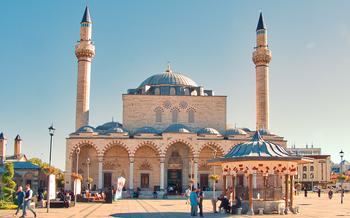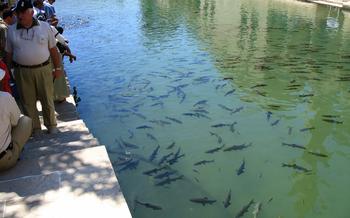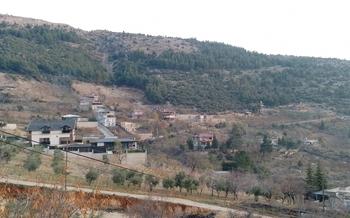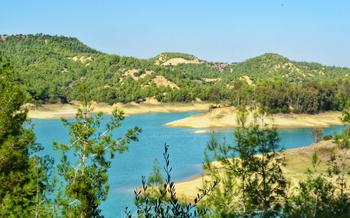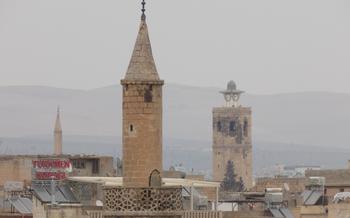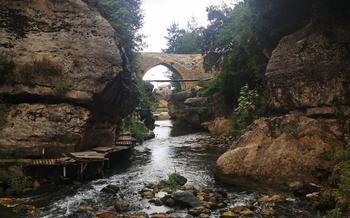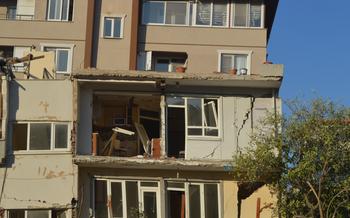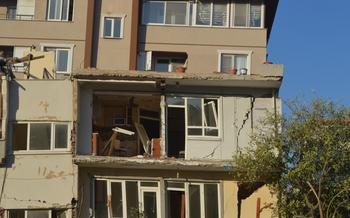
Eshab ı Kehf Cave (Seven Sleepers Cave)
- A Cave with a Mysterious Past:
- Location and Getting There:
- Visiting the Cave
- Exploring the Cave's Interior
- The Seven Sleepers Legend
- Pilgrimage and Religious Significance
- Archaeological Findings: Unraveling the Cave's Past
- Unique Atmosphere and Acoustics
- Surrounding Attractions
- Local Cuisine and Hospitality
- Photography and Videography
- Accommodation Options
- Local Customs and Etiquette
- Safety and Security
- Insider Tip: Unveiling the Hidden Chamber
A Cave with a Mysterious Past:
The Eshab ı Kehf Cave, also known as the Seven Sleepers Cave, holds a rich history and mysterious aura that has captured the imagination of travelers and pilgrims for centuries. Situated in the picturesque city of Kahramanmaraş, Turkey, the cave is believed to be the final resting place of the Seven Sleepers, a group of righteous young men who sought refuge in a cave to escape persecution. According to legend, they fell into a deep sleep that lasted for 309 years, only to awaken in a completely transformed world.
The cave's religious significance extends beyond the Islamic tradition, as it is also revered by Christians. The story of the Seven Sleepers appears in the Quran and the Bible, and the cave has become a sacred pilgrimage site for both faiths. Archaeological excavations at the site have unearthed valuable artifacts, including pottery, inscriptions, and coins, shedding light on the cave's ancient usage and its transformation into a place of worship and pilgrimage.
Location and Getting There:
The Eshab ı Kehf Cave is situated in the Afşin district of Kahramanmaraş, Turkey. To reach this awe-inspiring natural wonder, you can either embark on a scenic road trip or utilize the convenience of public transportation.
If you prefer the freedom of a self-guided journey, rent a car and set off on an adventure along the well-maintained roads leading to the cave. The drive offers breathtaking views of the surrounding landscapes, making it an enjoyable experience in itself.
Alternatively, you can opt for public transportation, which provides a budget-friendly and hassle-free option. Several buses depart from Kahramanmaraş city center daily, ensuring easy access to the cave. Once you arrive at the Afşin bus terminal, you can take a short taxi ride to reach the cave's entrance.
No matter your chosen mode of transportation, make sure to plan your route carefully, considering your starting point and the time you have available. The journey from Kahramanmaraş city center to the cave takes approximately two hours by car or bus.
Upon arrival, you'll find ample parking facilities near the cave, allowing you to leave your vehicle safely while you explore this subterranean marvel. Please note that there may be a small parking fee, so come prepared with some Turkish Lira.
Visiting the Cave
Visiting the Eshab ı Kehf Cave is a unique and awe-inspiring experience. The cave is open to the public during specific hours, usually from morning until evening. Guided tours are available for those who want to learn more about the cave's history and significance. These tours are conducted in various languages, ensuring that visitors from around the world can appreciate the site's importance.
The recommended duration of the visit depends on personal interests and time constraints. For those with a keen interest in history, religion, and culture, a longer visit is recommended to fully explore the cave's chambers and learn about its significance. For those with limited time, a shorter visit can still provide a glimpse into the cave's beauty and history.
Accessibility is a key consideration for visitors with limited mobility. While the cave is generally accessible, certain areas may be challenging to navigate due to uneven surfaces or narrow passages. Visitors with mobility concerns should plan their visit accordingly and consider requesting assistance if needed.
Exploring the Cave's Interior
The Eshab ı Kehf Cave is a labyrinth of chambers and passages, each with its own unique features. As you enter the cave, you'll be greeted by a large chamber known as the "Main Hall." This chamber is adorned with intricate carvings and inscriptions, some of which date back to the Roman period.
From the Main Hall, you can explore the cave's various chambers. One of the most notable features of the cave is its acoustics. The cave's natural acoustics create a reverberant effect, making it an ideal place for chanting and singing. This acoustic phenomenon is said to have contributed to the cave's mystical atmosphere and its association with religious figures.
As you explore the cave's interior, be sure to look out for the many inscriptions and carvings that adorn the walls. These inscriptions and carvings provide valuable insights into the history and usage of the cave. Some of the inscriptions are in Arabic, while others are in Greek, indicating the diverse cultural influences that have shaped the cave's history.
While exploring the cave, it's important to take safety precautions. Wear sturdy shoes and bring a flashlight, as the cave's interior can be dark and uneven. Also, be aware of your surroundings and avoid touching or disturbing any of the cave's delicate features.
The Seven Sleepers Legend
The legend of the Seven Sleepers is a captivating tale that has fascinated people for centuries. Originating in ancient times, it has been recounted in various cultures and religions, including Christianity and Islam. The story revolves around a group of seven young men who, to escape persecution, seek refuge in a cave. Miraculously, they fall into a deep slumber that lasts for an extended period, often centuries.
In the Christian version of the legend, the Seven Sleepers are Christian youths who flee from the Roman emperor Decius's persecution in the 3rd century AD. They hide in a cave, where they fall asleep. When they awaken, they discover that 200 years have passed, and Christianity has become the dominant religion.
In the Islamic tradition, the Seven Sleepers are known as the Ashab al-Kahf, or "Companions of the Cave." The story is narrated in the Quran, where it serves as a parable about faith and the power of God. The Seven Sleepers are depicted as righteous young men who seek refuge in a cave during the reign of a tyrannical ruler. They fall asleep and remain in a state of suspended animation for 309 solar years, or approximately 300 lunar years.
Over time, variations of the legend emerged, adding unique elements and interpretations. Some versions mention that a dog accompanied the Seven Sleepers, symbolizing loyalty and companionship. The dog's miraculous survival throughout the centuries further emphasizes the divine intervention in the story.
The legend of the Seven Sleepers holds profound symbolism and deeper meanings. It represents the triumph of faith over adversity, the enduring power of divine protection, and the concept of resurrection or rebirth. The story reminds us that even during times of hardship, hope and faith can prevail, and that God's timing and plans are beyond human comprehension.
Pilgrimage and Religious Significance
The Eshab ı Kehf Cave holds immense religious significance for both Muslims and Christians, attracting pilgrims from around the world. For Muslims, the cave is associated with the story of the Seven Sleepers, who are mentioned in the Quran as righteous youths who sought refuge in the cave to escape persecution. According to Islamic tradition, they slept for 309 years and awoke during the reign of a just ruler, symbolizing the power of faith and divine protection.
For Christians, the cave is associated with the legend of the Seven Sleepers of Ephesus, a similar tale of seven Christian youths who hid in a cave to avoid persecution during the Roman Empire. They are believed to have slept for centuries and awakened during the reign of Emperor Theodosius II, symbolizing the triumph of Christianity over paganism.
The cave's religious significance has transformed it into a place of pilgrimage, with visitors coming to pay their respects and seek blessings. Many pilgrims light candles, recite prayers, and leave offerings in the cave as a sign of devotion. The atmosphere is one of reverence and spirituality, as visitors connect with the stories and traditions that have made this cave a sacred site for centuries.
Archaeological Findings: Unraveling the Cave's Past
Archaeological excavations conducted at the Eshab ı Kehf Cave have unearthed a wealth of artifacts that shed light on its rich history and significance. Among the most notable discoveries are fragments of pottery, inscriptions, and coins. These artifacts date back to different periods, providing valuable insights into the cave's usage throughout history.
The pottery fragments found at the site belong to various styles and periods, ranging from the Roman era to the Ottoman period. These fragments offer clues about the daily life and activities that took place within the cave. Inscriptions found on the cave walls provide further historical context, revealing the names of visitors and pilgrims who left their mark over the centuries.
Coins discovered during the excavations are particularly significant as they help to date the cave's usage. These coins span a wide range of periods, from ancient Greek coins to Islamic coins minted during the Umayyad and Abbasid dynasties. The presence of these coins suggests that the cave was not only a place of religious significance but also a site of trade and commerce.
The archaeological findings at the Eshab ı Kehf Cave have greatly contributed to our understanding of its history and usage. These discoveries have helped to piece together the story of this sacred site, revealing its importance as a place of pilgrimage, worship, and human habitation throughout the ages. Ongoing research and excavations at the cave continue to uncover new artifacts and insights, promising to further illuminate the rich history of this remarkable site.
Unique Atmosphere and Acoustics
The Eshab ı Kehf Cave possesses an exceptional acoustic quality that has captivated visitors for centuries. The cave's unique shape and natural formations create an echo that resonates throughout its chambers, amplifying even the slightest sounds.
Visitors often experiment with the acoustics by clapping, singing, or playing musical instruments, creating a harmonious symphony that reverberates through the cave. The acoustics are so remarkable that even a whisper can be heard from across the chamber, adding to the cave's mystical and sacred atmosphere.
Scientific explanations attribute this phenomenon to the cave's geometry and the way sound waves bounce off its walls. The cave's high ceilings and irregular surfaces create multiple reflection points, resulting in a prolonged reverberation time.
This acoustic wonder contributes significantly to the cave's spiritual significance. The echoing sounds create a sense of awe and reverence, enhancing the meditative and prayerful experiences of visitors. The cave's acoustics have also been utilized for musical performances and recitals, transforming it into a natural concert hall.
Surrounding Attractions
Beyond the Eshab ı Kehf Cave, Kahramanmaraş and its surroundings offer a wealth of attractions that complement your visit.
-
Kahramanmaraş Museum: This museum houses a rich collection of artifacts and exhibits that showcase the region's history and culture. From ancient pottery to traditional textiles, the museum provides a glimpse into the diverse heritage of Kahramanmaraş.
-
Sütçü İmam Ali Saim Ülgen Park: This expansive park is a haven of tranquility and recreation, offering stunning views of the city and the surrounding mountains. With its lush gardens, walking trails, and playgrounds, the park is a popular spot for locals and tourists alike.
-
Kahramanmaraş Castle: Perched atop a hill overlooking the city, this ancient castle offers a glimpse into the region's rich history. Explore its fortifications, admire the panoramic views, and delve into the stories of past battles and sieges.
-
Elbistan Dam Lake: Located just a short drive from Kahramanmaraş, this serene lake is surrounded by picturesque landscapes. Enjoy a leisurely boat ride, try your luck at fishing, or simply relax and soak in the tranquility of nature.
-
Göksu Waterfall: This breathtaking waterfall cascades down a rocky cliff, creating a mesmerizing spectacle. Take a refreshing dip in the pool below, admire the stunning views, and capture some Insta-worthy shots.
By combining your visit to the Eshab ı Kehf Cave with these surrounding attractions, you can create a comprehensive and memorable travel experience in Kahramanmaraş.
Local Cuisine and Hospitality
Kahramanmaraş is renowned for its culinary delights, and a visit to the Eshab ı Kehf Cave is an opportunity to savor the local flavors. The city is famous for its Maraş ice cream, with its unique stretchy texture and rich taste. Indulge in a scoop or two of this frozen treat to cool down after exploring the cave.
For a traditional meal, try the "Maraş Usulü Tantuni", a local specialty consisting of grilled lamb or beef wrapped in thin lavash bread. The meat is seasoned with cumin, red pepper, and garlic, creating a flavorful and aromatic dish.
Vegetarians will delight in the variety of meze (appetizers) available, such as "hummus", "baba ghanoush", and "ezme". These dips and spreads are perfect for sharing and can be enjoyed with freshly baked bread.
To satisfy your sweet tooth, try the "Katmer", a flaky pastry filled with nuts and sugar. This delicious dessert is a must-try for anyone with a sweet tooth.
When it comes to hospitality, the people of Kahramanmaraş are known for their warm and welcoming nature. Locals are always ready to assist visitors with directions, recommendations, or even just a friendly conversation.
Embrace the local culture and customs by trying out some Turkish phrases. A simple "Merhaba" (hello) or "Teşekkür ederim" (thank you) goes a long way in showing your appreciation and respect.
Whether you're a foodie or simply looking to experience the warmth of Turkish hospitality, Kahramanmaraş has something to offer every traveler.
Photography and Videography
The Eshab ı Kehf Cave offers a unique opportunity for photography and videography enthusiasts to capture the beauty and mystery of this ancient site. The cave's atmospheric lighting and fascinating rock formations create a visually stunning backdrop for your shots.
To make the most of your photographic experience, consider bringing a tripod to stabilize your camera and capture sharp images in low-light conditions. Experiment with different angles and perspectives to capture the cave's grandeur and intricate details.
Be mindful of other visitors when taking photos and videos, and avoid using flash photography, which can be disruptive and disrespectful. Instead, utilize the cave's natural light to create a more authentic and evocative atmosphere in your images.
Share your experiences with the world by posting your photos and videos on social media or travel blogs. Use relevant hashtags and tags to connect with other travelers and photography enthusiasts who share your passion for exploring hidden gems.
Accommodation Options
When planning your visit to the Eshab ı Kehf Cave, you'll need to consider your accommodation options in Kahramanmaraş. The city offers a range of choices to suit different budgets and preferences.
For budget-conscious travelers, there are several hostels and guesthouses that provide basic yet comfortable accommodations. These options typically offer shared dormitories or private rooms at affordable prices.
If you prefer a bit more comfort and privacy, mid-range hotels are available in the city center. These hotels usually offer private rooms with amenities such as air conditioning, Wi-Fi, and en-suite bathrooms.
For a truly luxurious experience, consider staying at one of the high-end hotels in Kahramanmaraş. These hotels offer spacious rooms, top-notch amenities, and impeccable service.
To secure the best deals and avoid disappointment, it's advisable to book your accommodation in advance, especially during peak tourist seasons. Online booking platforms and travel agents can assist you in finding the perfect place to stay based on your budget and preferences.
Local Customs and Etiquette
When visiting the Eshab ı Kehf Cave and interacting with locals in Kahramanmaraş, it's essential to be mindful of local customs and etiquette to ensure a respectful and enjoyable experience. Here are some guidelines to keep in mind:
-
Dress Code: Dress modestly and respectfully, especially when visiting religious sites. Avoid revealing or tight clothing.
-
Behavior: Behave respectfully and refrain from loud or disruptive behavior. Show respect for the cave's religious significance and avoid any actions that may be considered offensive.
-
Photography: Ask permission before taking photos of local people, especially women. It's also important to be mindful of the privacy of other visitors when taking photos or videos inside the cave.
-
Cultural Sensitivity: Be open to learning about and appreciating the local culture. Show interest in local customs and traditions, and avoid making judgments or comparisons.
-
Interacting with Locals: When interacting with locals, be friendly and respectful. A smile and a greeting can go a long way in fostering positive interactions.
By observing local customs and etiquette, you can show respect for the local community and contribute to a positive and memorable experience for yourself and others.
Safety and Security
When exploring the Eshab ı Kehf Cave, your safety and security should be a top priority. Here are some essential tips to keep in mind:
-
Be aware of your surroundings: Stay alert and pay attention to your surroundings while exploring the cave. Watch out for uneven surfaces, low-hanging rocks, and slippery spots.
-
Wear appropriate footwear: Proper footwear is crucial for a safe and comfortable cave exploration. Opt for sturdy shoes or hiking boots with good traction to navigate the cave's uneven terrain.
-
Carry a flashlight or headlamp: The cave can be dark in some areas, so bring a reliable flashlight or headlamp to illuminate your path. This will help you see obstacles and avoid tripping or bumping into cave walls.
-
Stay on designated paths: Respect the designated paths and trails within the cave. Avoid venturing off into unexplored areas or climbing on rocks or ledges unless you have the proper training and equipment.
-
Be mindful of your belongings: Keep your personal belongings close to you at all times. Avoid leaving valuables unattended, as the cave is a popular tourist destination, and theft can occur.
-
Follow local regulations: Familiarize yourself with local regulations and guidelines regarding cave exploration. Obey any signs or instructions posted within the cave, and respect the rules and regulations set in place for the safety of all visitors.
-
Be prepared for emergencies: While unlikely, it's essential to be prepared for emergencies. Keep a first aid kit handy and know the location of the nearest medical facilities. In case of an emergency, dial the local emergency number or seek assistance from cave staff or guides.
-
Stay informed: Before your visit, check for travel advisories and safety updates related to the region. Keep yourself informed about any potential risks or concerns in the area, and adjust your plans accordingly.
Insider Tip: Unveiling the Hidden Chamber
Beyond the main chambers of the Eshab ı Kehf Cave lies a hidden gem, a secret chamber known only to a few. This secluded space, tucked away from the main tourist routes, offers a unique and intimate experience for those willing to venture off the beaten path.
To reach the hidden chamber, one must crawl through a narrow passageway, revealing a small, yet awe-inspiring space. The walls are adorned with intricate carvings and inscriptions, telling tales of ancient civilizations and forgotten histories. The atmosphere is serene and contemplative, inviting visitors to connect with the cave's spiritual essence.
Discover the hidden chamber and immerse yourself in a realm of mystery and wonder. Let the cave's secrets unfold before you, creating memories that will last a lifetime.
